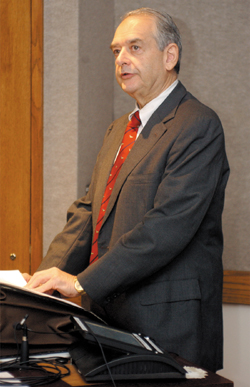
Dr. Lawrence Altman speaks at Grand Rounds last week at VUMC. (photo by Dana Johnson)
Award-winning journalist informs doctors, world
Several weeks ago Dr. Lawrence Altman was busy writing a story for The New York Times about the “uncomfortable metamorphosis” of the Centers for Disease Control after Sept. 11 as the governmental agency shifted from controlling naturally transmitted diseases to becoming heavily involved with bioterrorism. He planned to spend the weekend writing the story before he left to both cover and speak at the Nobel Prize festivities in Sweden.
Shortly before he left his New York City office, a news release from the Florida Health Department came across his desk about the state’s second West Nile Virus case of the year. Some reporters might have tossed it in the trash, but Altman read the release from start to finish and noticed that the 71-year-old patient had undergone a recent organ transplant. The release made no correlation between the two, but a phone call confirmed what Altman suspected — that the two might be related. His breaking news story missed the first edition, but made the subsequent editions.
Altman wrote three stories in three days about the Florida case in which four patients ended up being infected with West Nile Virus either through a blood transfusion or the organs they received. He left an unedited draft of a fourth story and caught a last-minute flight to Sweden. He arrived, jetlagged, just in time for his speech.
Altman, The New York Times medical correspondent, spoke about medical reporting at Vanderbilt University Medical Center’s Infectious Diseases Grand Rounds last week. Dr. William Schaffner, professor and chairman of Preventive Medicine, who worked with Altman at the CDC prior to his joining The New York Times, called Altman “the dean of medical correspondents in this country.” Altman edited the CDC’s Morbidity and Mortality Weekly Report for three years.
At the CDC, he spent time working on the elimination of measles through a measles immunization program for eight West African countries, which later was merged with the World Health Organization’s program that eradicated smallpox from the world.
“So what goes around, comes around,” Schaffner said. “Here he is dealing with smallpox again.”
Altman is one of the few medical doctors working as a full-time daily newspaper reporter and has been on the staff of The New York Times since 1969. In 1985 he received a George Polk Award, one of America’s most coveted journalism honors, for his series on AIDS in Africa.
For the past 33 years, Altman has written approximately 100 stories a year for The New York Times on a variety of medical subjects. He spent much of 2000 writing stories about the health of the presidential and vice presidential candidates. During 2001 his focus was the health of Vice President Dick Cheney and the AbioCor replacement heart. From Sept. 11 on, his reporting has been focused on bioterrorism, with a heavy infectious disease slant. But Sept. 11 wasn’t the first time Altman considered the threat of smallpox. In 1999 he wrote a 4,000-word story about the use of smallpox as a scourge.
“I believe that public health should be at the top of the list of medical stories at any newspaper,” Altman told the group. “I’ve just returned from Sweden from the Nobel Prize ceremony where it occurred to me that there have been no prizes awarded for a public health focus.”
Altman said that although many of his stories have received attention, none received more negative attention than a story that he wrote in the 1980s on the link between Helicobacter pylori (H. pylori) bacteria and peptic ulcers. When a source called his attention to the possible link, Altman called one of the country’s leading gastroenterologists for a response. The physician told him he had just returned from his society’s annual meeting and there was no mention of H.pylori at the meeting. Altman wrote the article anyway, and the link was soon proven to be legitimate.
“I’ve never seen the medical community more defensive or more critical of a story,” Altman said. “They argued that with no evidence, this couldn’t be.”
Altman said that physicians and journalists are actually alike in the way they do their jobs.
“I submit that doctors and journalists go through the same process but each of us use different words to describe the same effect. The best clinician takes the best histories and the best journalist asks the most probing questions,” he said.













